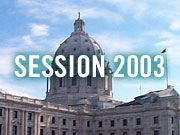Photos
More from MPR
Resources
Your Voice
| ||||||||||||||||||||||||||||||||||||||||||||||||||
New grad standards released while education budget is debated
April 15, 2003
 |
| Demonstrators at the Capitol Monday called on lawmakers and the governor to spare early childhood education from budget cuts. (MPR Photo/Michael Khoo) |
St. Paul, Minn. — Throughout his career as a legislator, and during his time on the campaign trail, Gov. Pawlenty consistently called for replacing the Profile of Learning with a back-to-basics approach. His administration unveiled a draft set of English and math standards last month -- and has refined the plan based on public input from around the state. Pawlenty says the new guidelines will launch Minnesota back into the lead on education matters.
"It's important that Minnesota maintain and build upon its reputation as a being nation-leading education reform and innovation and standards state. And that certainly involves having standards that are rigorous, that are high-quality, that are grade-specific, and that are viewed as nation-leading," Pawlenty says.
The new standards are fact-oriented. For instance, by third grade, students will be expected to write a basic paragraph. Fifth graders should know that the sum of the interior angles of a triangle is 180 degrees.
Pawlenty wants the standards adopted for the next school year, in time to prepare students and schools for the requirements of the federal No Child Left Behind legislation. The House has already adopted a plan to repeal the Profile and accomodate the administration's new standards.
The Senate has taken a slightly different approach. Sen. Steve Kelley, DFL-Hopkins, chairs the Senate Education Committee. He's proposing to repeal the Profile, but replace it with standards drafted from some of its old elements. Pawlenty calls that approach, "Profile of Learning II, the sequel." But Kelley says the administration's initial approach, led by Children, Families, and Learning commissioner Cheri Pierson Yecke, was too simplistic.
"There were a lot of things that were left out, that represented high-order thinking skills -- kind of deep knowledge that students were expected to have. And they opted for a checklist approach instead," says Kelley.
A Senate Education Finance Division voted Monday to approve Kelley's plan. It now awaits action before the full Senate.
The House Education Finance Committee was also in action. Members took up a $12 billion spending bill that funds schools, early childhood education, and adult education programs. Committee chair, Rep. Alice Seagren, R-Bloomington, says the package closely matches Pawlenty's own education recommendations, and mostly preserves education funding.
"It doesn't hit every district evenly, because some gain more and some lose some. There is a reduction, certainly, from current law. But it's not nearly the extent that other areas have, like health and human services, have received. So, I think that we have tried very, very hard to protect K-12," says Seagren.
Pawlenty and House Republicans had pledged to spare K-12 education from plans to erase a $4.2 billion projected deficit. And Seagren says the proposed K-12 cut is slight --- about .03 percent of the general education budget. But the plan also changes how funds are distributed, including a plan to distribute more broadly funding for students from poor families.
That could draw resources away from Minneapolis, St. Paul, and other districts with high concentrations of low-income students. Jim Grathwol represents the Minneapolis School District. He says, even without the changes in the House bill, education was likely to suffer.
"The first thing to note is that in both the governor's proposal and the House proposal, they're operating under no new revenue. And that's not good for education statewide. No increase in the general ed formula for the next two years is a problem. Costs will increase," Grathwol says.
The House plan does restore some of Pawlenty's cuts for summer school, after-school programs, and early childhood education. Yet it is also makes deep cuts in state funding for Head Start. Senate DFLers have promised to maintain education funding at all levels, but have yet to release a detailed plan.
|
News Headlines
|
Related Subjects
|

